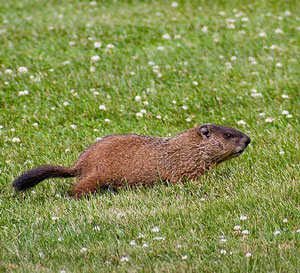Do I Need to Get Rid of That Friendly Woodchuck?
By Chris Williams on September 26, 2013.
 Sure, they’re fun to watch but living with a woodchuck in your yard is like babysitting a 200-lb. puppy! They’re big and they can leave a lot of damage in their wake.
Sure, they’re fun to watch but living with a woodchuck in your yard is like babysitting a 200-lb. puppy! They’re big and they can leave a lot of damage in their wake.
Woodchucks (also known as groundhogs) are unusually busy at this time of year as they try to put on fat for hibernation. They’re active during the daytime and you’ll see them foraging mostly in early morning and early evening. With their large size and short legs, woodchucks seem to waddle along as they search for food. Some people are worried that seeing a woodchuck out foraging or basking in the sun during the day means it might be rabid. Although woodchucks can get rabies, daytime activity is normal for them.
People can peacefully coexist with woodchucks because they’re not aggressive and typically don’t transmit diseases. But it’s usually the sheer size of the animal that is its undoing. A smaller burrowing animal like a chipmunk is more easily overlooked. Woodchucks are large animals (up to 12 pounds) and have huge burrows even though there is only one occupant — unless mom has babies. The main opening to the underground burrow can be a foot across and will usually be marked by a large pile of excavated dirt. It can be a real “ankle buster.” There may be two or more secondary burrow openings as well. The entire burrow system can be as deep as five feet and more than 30 feet long. The main nest chamber is lined with grasses. There is even a separate chamber just for pooping—which explains why woodchuck burrows usually are marked by flies around the opening.
The location of the burrow can be a problem, too. Normally woodchucks will burrow in meadows and pastures, and along fence rows or along wood edges. In suburban areas, they tend to burrow under sheds, barns, porches, stonewalls, and under woodpiles. Their extensive burrows can undermine building foundations. Collapsing ground burrows cause other problems for lawn tractors, horses, and people that fall through. Other animals like raccoons and skunks will often inhabit unused woodchuck burrows.
If the burrow doesn’t convince the homeowner that the animal needs to go, its feeding damage often will. It takes a lot of food to fill up a woodchuck and much of that food will come from your garden and your fruit trees. Woodchucks are mostly herbivores or plant eaters, but they will supplement their diet with insects, snails, and baby birds and eggs (yes, they can climb trees). They love all types of garden vegetables and fruits.
Woodchucks are one of the few animals in our region that has true hibernation like a bear. In other words, the woodchuck lowers its breathing rate, heart rate, and body temperature and hunkers down in its burrow for the winter. During this time, the woodchuck can lose 20 to 30% of its body weight. Even though it enters a state of inactivity, it is not unusual for a woodchuck to break its hibernation once or twice during the winter and be seen foraging outside.
There can be young (usually 4 to 5) in a female’s burrow in late winter or early spring, so removal of a woodchuck needs to be properly timed. The job should also be done by a wildlife specialist licensed and trained in humane removal of nuisance wildlife. At Colonial, we have been removing wildlife for more than 25 years. If you’re thinking of filling in or destroying the burrow to get the woodchuck to move on, that usually doesn’t work. Give Colonial a call instead.
Photo credit: eclectic echoes / Foter / CC BY-NC